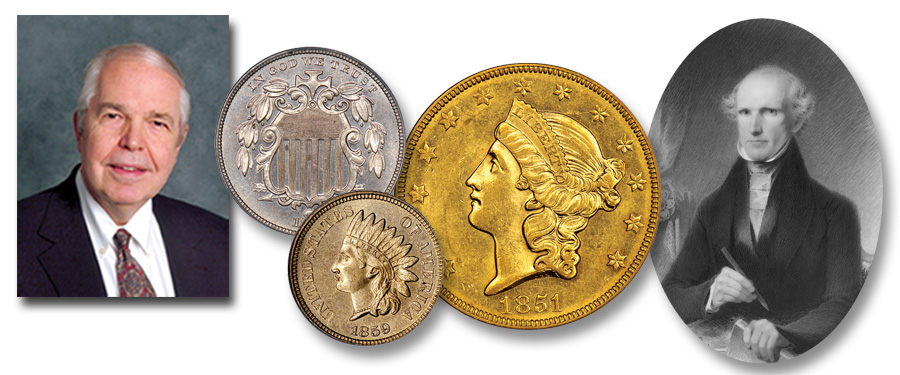
Today James Barton
Longacre (October 11, 1794 – January 1, 1869) stands as one of the best
remembered nineteenth century engravers at the Philadelphia Mint. His
most famous signature is the tiny letter L on the ribbon of the Indian Head
cent. A bronze 1864 cent with an L is a key issue, and one lacking this letter
is common.
In the early years of
his career Longacre was employed as an engraver of bank note plates in
Philadelphia by Murray, Draper, Fairman & Company (who earlier had
Christian Gobrecht on the staff). His magnum opus was engraving many of the
plates for the National Portrait Gallery of Distinguished Americans published
in Philadelphia in 1839. Today it is an interesting exercise to collect images
of the many bank notes he engraved, many of which are available on the
internet. The notes themselves can be inexpensive, and the main challenge—an
interesting pursuit—is tracking them down. No complete catalog of these has
ever been compiled. As a side note, in a caper in 1874 it was published that Longacre
had been secretly employed by the Confederate States of America in 1861 to
create the dies for a one-cent piece. Such pieces began to appear on the
market, including “originals” in copper-nickel and restrikes in copper, silver,
and gold. These in fact were modern fantasies. Debunked, they no longer have
the numismatic status that they enjoyed decades ago.
The Indian Head cent
featuring Longacre’s famous design was first made in pattern form in 1858, then
in circulation in 1859. These had an olive or laurel (the Mint used both terms)
wreath on the reverse. In addition, about 1,500 pieces were struck with the
Shield reverse but not released into circulation. These are sometimes called
patterns, but it is more accurate to call them circulation issues that never
reached the channels of commerce. Examples seen today are typically well-struck
and very lustrous. The eighteenth edition of the Standard Catalogue
of United States Coins listed these among regular issues, an idea that
was never picked up by the Guide Book of United States Coins.
Among my fond memories
of when I was a young teenager fresh to the world of coin collecting was a
visit to the owner of the Martz bus line in northeastern Pennsylvania. For many
years one of the drivers had kept Indian Head cents that were paid as fares,
and I was allowed to look through a cigar box filled with them. Being of a
curious turn of mind then (as now) I wondered how rare the 1864 bronze cents
with L on the headdress ribbon were in comparison to those lacking this letter.
The ratio was about one to three.





